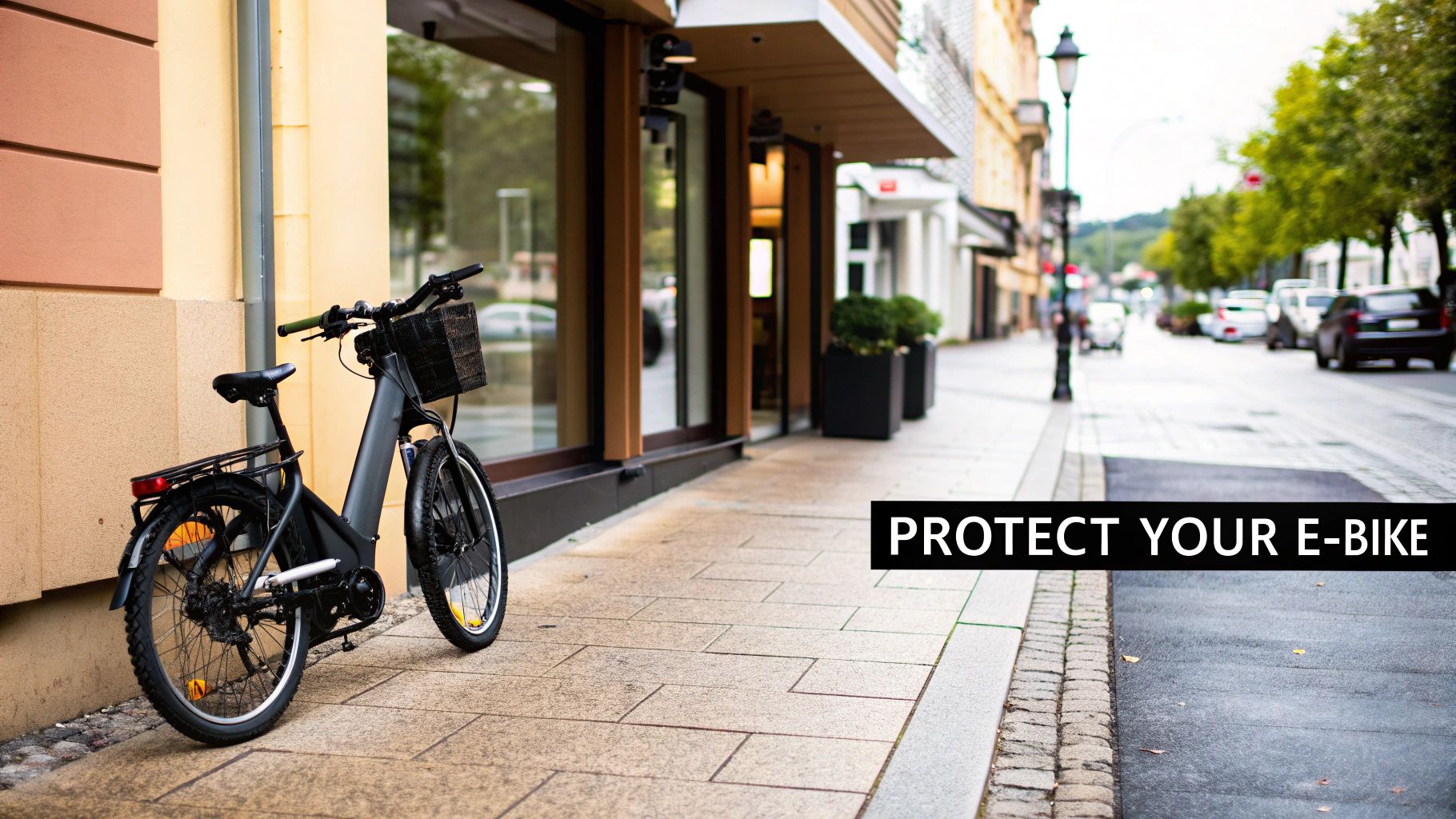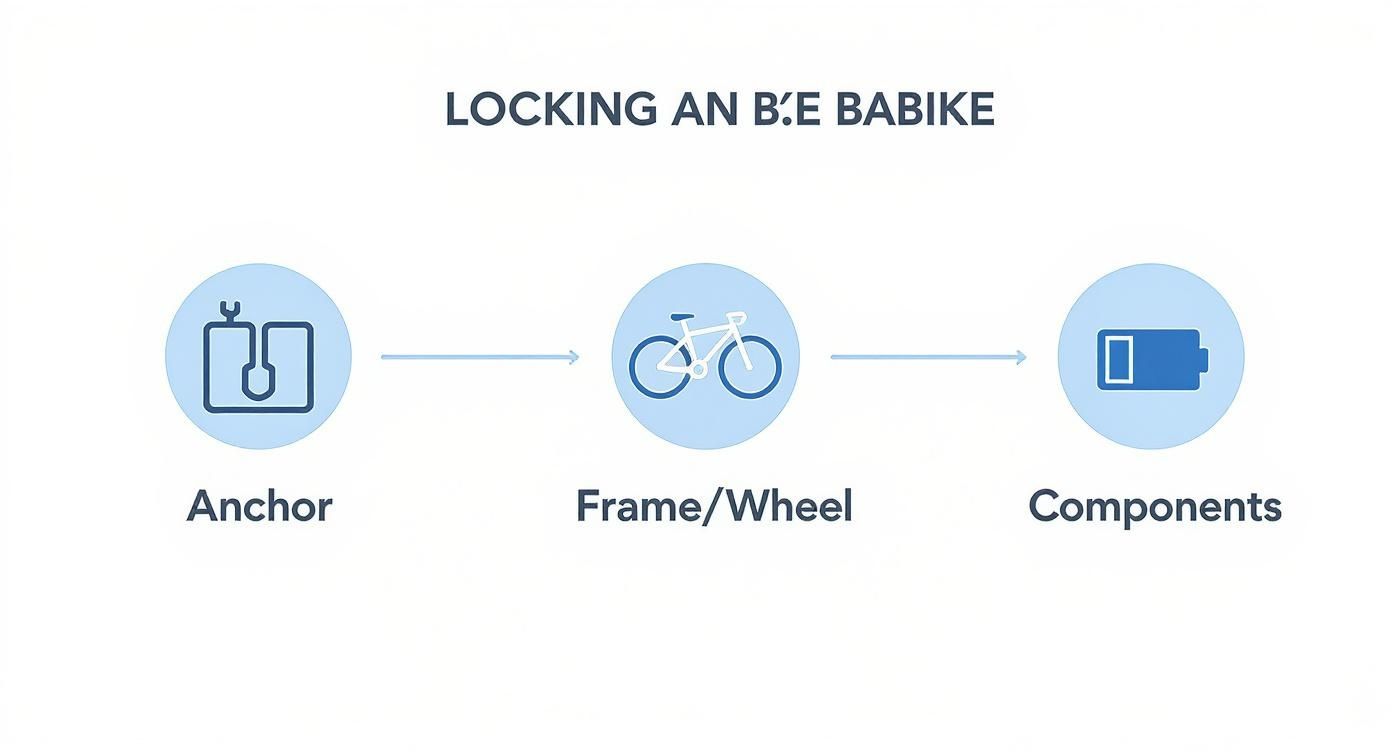The best lock for an electric bike is almost always going to be a high-security U-lock or a beast of a chain lock, ideally one with a Sold Secure Gold or Diamond rating or a comparable certification in your region. These are the locks built to stand up to the serious tools that thieves use when they’re hunting for high-value e-bikes like yours.
Why Your E-Bike Needs a Serious Security Plan

So, you’ve joined the e-bike revolution! It’s an incredible feeling, right? Whether it’s transforming your daily commute in a bustling US city or powering up your weekend adventures along the Australian coast, an e-bike is a big deal. But that awesome investment brings a critical question to the table: how do you keep it safe?
Let’s be real. If you’re thinking about using that dusty old cable lock from your ten-speed, it’s time for a serious rethink. E-bikes aren't just regular bikes with a motor; they're high-value targets for thieves. Their price tags, expensive components like batteries and motors, and sheer popularity make them irresistible. This isn't about scaring you—it's about getting you ready to protect your ride the right way.
The Sobering Reality of E-Bike Theft
The e-bike market is absolutely booming. Projections show it rocketing from $32 billion in 2025 to nearly $120 billion by 2030. That's a lot of e-bikes on the streets, and thieves from New York to Sydney have definitely noticed.
Here's the tough part: e-bikes are about three times more likely to be stolen than regular bikes. Even more telling is that a massive 59% of stolen bikes were actually locked when they were taken. That statistic alone proves that just any old lock won't cut it anymore.
This means that simply locking up your bike isn't enough. The quality of your lock and how you lock it are what really separate a safe bike from a stolen one.
The mindset has to change from 'any lock will do' to 'I need a real security strategy for my e-bike.' It’s about picking the right tools for the job and using them correctly every single time.
It’s More Than a Lock—It's a Full Security Strategy
Thinking about e-bike security means going beyond just buying one heavy lock. You need to create layers of defense that make a potential thief look at your bike and think, "Nope, too much trouble," and move on.
A complete security plan really boils down to four key things:
- Choosing the right lock: Picking one with a certified security rating that matches your risk level.
- Proper locking technique: Knowing the best way to secure your frame (and wheels!) to something solid.
- Component security: Locking down your valuable parts like the battery, display, and even your seat.
- Considering insurance: Adding a financial safety net for true peace of mind. For a deeper dive, check out our guide on the costs of electric bike insurance.
Throughout this guide, we'll walk through exactly how to build this strategy, starting with the heart of the matter: the locks themselves. Choosing the best lock for an electric bike is all about striking that perfect balance between hardcore security and everyday convenience.
Choosing Your Weapon: U-Locks vs. Chains vs. Folding Locks

When it's time to pick a lock for your e-bike, you’ll quickly find yourself staring down three main contenders. Think of them as different types of security guards for your ride, each with its own special set of skills. Let's get to know the big three—U-locks, chain locks, and folding locks—so you can confidently choose the right partner for your daily grind.
This isn't just about buying a piece of metal. It's about figuring out how the lock's design meshes with your life—where you park, how much gear you're willing to haul, and how much peace of mind you need.
The Unyielding Bodyguard: U-Locks
U-locks (also known as D-locks in some regions) are the original titans of serious bike security. They're basically a giant, hardened steel shackle in a 'U' shape that clicks into a crossbar. Their main claim to fame? They are incredibly tough against cutters and pry bars.
That rock-solid design is also their biggest catch. While it makes them a fortress, it also makes them inflexible. Trying to get one around a fat e-bike frame and a chunky lamppost can feel like a game of Tetris you’re doomed to lose.
A U-lock's rigidity is its greatest defensive asset. By leaving as little space as possible inside the 'U' when locked, you deny thieves the room they need to get leverage with their tools, making it a much harder nut to crack.
The Adaptable Security Detail: Chain Locks
If you need a lock that can go anywhere, a chain lock is your best friend. Made of beefy, hardened steel links, they can snake around just about anything—thick poles, weirdly shaped bike racks, or through both your wheels and frame. This adaptability is a lifesaver in the unpredictable urban jungle.
The downside? The weight. A truly secure chain lock is seriously heavy. Carrying one in your backpack is basically a workout. They offer phenomenal protection, but you have to be willing to lug that beast around.
The Clever Engineer: Folding Locks
Folding locks are the new kids on the block, designed to solve the problems of the other two. They're built from a series of steel bars connected by pivoting rivets, all of which fold down into a slick, compact package you can mount right on your bike. They give you way more locking options than a U-lock but are a heck of a lot easier to carry than a chain.
That convenience does come with a small trade-off, though. Those pivot points, while strong, can be a weak spot for a really determined thief with the right tools. They're a fantastic middle-ground solution, but if you're parking in a high-risk area, a beefy U-lock or chain usually still wins on pure strength.
E-Bike Lock Types At a Glance
Still trying to decide? This table breaks it down, comparing the big three mechanical lock types to help you find your perfect match.
| Lock Type | Primary Pro | Primary Con | Best For |
|---|---|---|---|
| U-Lock | High resistance to cutting and prying | Limited flexibility and locking options | Daily commuting in areas with standard bike racks |
| Chain Lock | Maximum flexibility for awkward objects | Very heavy and cumbersome to carry | Securing your bike in diverse locations or at home |
| Folding Lock | Excellent portability and compactness | Pivots can be a potential weak point | Riders who value convenience and easy transport |
Ultimately, the best lock for your electric bike comes down to what you need it to do. Security is a huge part of the e-bike experience, but it's just one piece of the puzzle. For more ideas on kitting out your ride, check out our guide on the best electric bike accessories.
Cracking the Code on Security Ratings and Materials
Let’s be honest, picking a lock based on how tough it looks is a surefire way to get your bike stolen. What really separates a top-tier e-bike lock from a piece of junk is what's on the inside—the materials it's made from and the security certifications it’s earned. Let’s break down what those labels on the packaging actually mean so you know what you’re buying.
When you’re looking at locks, you’ll often see ratings from independent testing agencies. These aren't just marketing buzzwords; they’re hard-earned grades that show how much abuse a lock can withstand from a would-be thief. For anyone with an e-bike, there are a couple of names you should know.
Understanding Sold Secure and ART Ratings
While based in the UK, Sold Secure is a globally recognized benchmark for lock security. This non-profit is run by the Master Locksmiths Association, and their ratings are so trusted that insurance companies worldwide often require them. Seriously, if your e-bike gets nabbed and your lock didn't have the rating your insurer required, they might just deny your claim.
Here’s a quick rundown of what their bicycle ratings actually mean for you:
- Gold: This is a solid level of security. It’s designed to resist a determined thief with a bunch of tools for a few minutes. For most e-bikes, this is the absolute minimum you should be looking at.
- Diamond: This is the top dog for bicycle locks. These beasts are built to fight off attacks from heavy-duty tools, including some angle grinders, for a good chunk of time. If you park in a high-risk area, this is what you want.
Another respected rating system is ART, a Dutch standard recognized internationally. Their 1-to-5-star system is also a reliable indicator of toughness. For a pricey e-bike, you’ll want to find a lock with an ART rating of 3 stars or more.
Why Materials and Thickness Matter
Beyond the official ratings, the physical construction of a lock is everything. Think of a U-lock shackle or a chain link like a castle wall—the thicker it is, the tougher it is to get through. The best material, without a doubt, is hardened steel, which is specially treated to fight back against cutting, drilling, and prying.
The difference between a 14mm shackle and an 18mm one might not sound like much, but it's huge in practice. That extra 4mm of hardened steel can be the difference between a thief slicing through it in 30 seconds and them just giving up and walking away.
It’s a classic mistake to assume a thick plastic coating means a strong lock. A lot of cheap locks are just thin, weak metal hidden inside a bulky plastic shell. Always, always check for a security rating and confirmation that it's made of hardened steel.
This brings us to a critical point about cable locks. While the global bike lock market is projected to hit USD 1.8 billion by 2026, a huge chunk of that market is made up of simple cable locks. For e-bike owners, these things offer a dangerously false sense of security. Even the beefiest-looking cable can be snipped in seconds with a pair of cheap bolt cutters. If you're curious about market trends and why experts scream "no!" at cable locks for valuable bikes, you can dig into the latest bike cable lock research.
Are Smart Locks the Future of E-Bike Security?

While a big chunk of hardened steel will always be the first line of defense, technology is bringing some serious brains to the e-bike security game. Smart locks are doing more than just stopping someone from rolling your bike away; they’re turning into active security systems that keep you connected to your ride, wherever you are.
Think of it this way: a traditional lock is a silent gatekeeper. A smart lock, on the other hand, is like a vigilant security guard with a direct line to your phone. It can ping you the second it senses trouble, giving you a precious head start to do something about it.
This isn't just a niche gadget for tech lovers, either. The global market for smart bike locks was already worth around $0.5 billion in 2023 and is expected to rocket to $1.8 billion by 2032, growing at a blistering 15.2% a year. That’s a clear signal that riders are looking for smarter ways to protect their valuable e-bikes. You can dig into more of the numbers in this industry report from Dataintelo.
Features That Are Changing the Game
So, what makes a smart lock so tempting for an e-bike owner? It's all about the layers of protection that work together, giving you a kind of peace of mind that a simple mechanical lock just can't offer.
These aren't just toys; they’re genuinely practical tools for today’s rider.
- Keyless App-Based Entry: Forget digging around for keys. With a smart lock, you can unlock your e-bike with a quick tap on your phone. It makes jumping on your bike for a quick ride totally seamless.
- Motion-Sensitive Alarms: Most smart locks come with built-in sensors. If a thief starts messing with your bike, the lock can unleash a deafening alarm, drawing a ton of unwanted attention and hopefully scaring them off before they can even get started.
- Live GPS Tracking: This is the ultimate safety net. If the worst happens and your bike gets nicked, the lock's GPS can pinpoint its location in real-time. This gives you—and the police—a fighting chance of getting it back.
A smart lock essentially gives your e-bike a voice. It can shout for help when it's in trouble and tell you exactly where it is, turning a passive object into an active, trackable asset.
These clever features tackle the biggest fears that come with owning a pricey electric bike. By giving you instant alerts and a way to recover your bike, they offer a proactive defense system, making them a very serious contender for the best lock for an electric bike.
The Right Way to Lock Your Electric Bike
Owning a beast of a lock is a great first step, but it’s only half the battle. Seriously, even a diamond-rated lock won't do you much good if you use it the wrong way. The real secret to keeping your ride safe is all in the technique—your goal is to make your bike look like way too much hassle for any would-be thief.
Think of it this way: thieves are opportunists. They’re looking for a quick and easy score. A bike that’s locked up tight and looks like it'll take ages to mess with will almost always get a pass for an easier target down the street.
The Gold Standard Locking Method
The most tried-and-true technique is all about securing the most valuable parts of your bike to something that absolutely cannot be moved. Make this your go-to move every single time you park.
Your main goal is to thread your primary lock—whether it's a beefy U-lock or a heavy-duty chain—through three crucial things:
- The Main Frame: Always, always, always lock through the main triangle of your bike's frame. This is the heart of your bike, and it’s the most expensive part to replace.
- The Rear Wheel: On an e-bike, the rear wheel is often home to the hub motor, making it an incredibly valuable and tempting target. Locking it up is non-negotiable.
- An Immovable Object: This is the anchor that holds your whole security setup together.
The trick is to fill up as much of the empty space inside your lock as you can. A tight, snug fit gives a thief zero room to jam a crowbar or other tool in there and try to pry your lock open.
Choosing Your Anchor Wisely
What you lock your bike to is just as critical as the lock you use. A weak anchor point makes even the toughest lock totally useless. Why would a thief struggle with your hardened steel lock when they can just snip whatever it’s attached to?
Good Anchor Points:
- Properly installed bike racks that are cemented into the ground.
- Thick, sturdy metal signposts (give it a wiggle and check that the sign can't just be lifted off!).
- Solid metal railings that are bolted securely into concrete.
Bad Anchor Points to Avoid:
- Small trees or saplings. A thief with a small saw can get through those in no time.
- Chain-link fences. These can be cut with bolt cutters in a matter of seconds.
- Anything that can be unbolted or simply lifted, like a loose signpost or a temporary barricade.
Securing Your E-Bike’s Components
Last but not least, don't forget about the "e" in your e-bike. The battery is often the single most expensive part of your ride and a major target for thieves.
Whenever you park, especially if you'll be gone for a while, always remove your battery and display and take them with you. It might seem like a pain, but it’s worth it. For other parts like your front wheel and saddle, grabbing a secondary cable lock or a smaller D-lock is a smart move to keep everything buttoned up.
Building Your Personal E-Bike Security Checklist
Figuring out the perfect lock isn't a one-size-fits-all deal. It really comes down to creating your own personal security plan—matching the right hardware to your daily routine, the risks you face, and what you're willing to spend. To get it right, you've got to be honest with yourself about how and where you use your e-bike.
This decision tree gives you a simple, visual guide to locking your e-bike correctly every time.

As you can see, the best approach involves layers. You start with a solid anchor and make sure you secure both the frame and other key parts for the best protection.
Your Essential Security Questions
Before you click "buy now" on any lock, take a minute to run through this quick mental checklist. Your answers will steer you straight to the right gear.
- Where do I park? Locking up in a busy, high-risk city center like Chicago or Melbourne requires a much beefier lock (we're talking Sold Secure Diamond level) than parking inside a secure office garage.
- How long will I be gone? A quick five-minute coffee run is a totally different ballgame than leaving your bike chained to a pole all day while you're at work. The longer it's there, the bigger the target it becomes.
- What does my insurance require? This one is a huge deal. Many insurance policies are void if your bike gets stolen and you weren't using a lock with a specific rating—usually Sold Secure Gold or higher. Always check the fine print!
- What's my budget? It’s always tempting to go for the cheaper option, but remember this: a top-tier lock is a small investment to protect something that costs thousands of dollars. Skimping here could cost you big time later.
To make this even clearer, let's map out your risk level to the right kind of lock.
Match Your Risk to the Right Lock
Use this simple table to quickly identify what type of security you need based on your specific situation.
| Risk Level | Parking Location | Recommended Lock Type | Minimum Security Rating |
|---|---|---|---|
| Low | Secure garage, office bike room, quiet suburb | Folding Lock or lightweight U-lock | Sold Secure Silver |
| Medium | Daytime city parking, college campus, busy street | Heavy-duty U-lock or Chain Lock | Sold Secure Gold |
| High | Overnight street parking, major city center, high-crime area | Two locks: U-lock + Chain Lock | Sold Secure Diamond |
This table should give you a great starting point for finding a lock that actually meets your needs, not just one that looks tough.
The smartest way to secure your bike is often to use two different types of locks. A U-lock on the frame and a chain on the front wheel forces a thief to carry and use two different kinds of tools. That extra hassle dramatically increases the time and effort they need, making them more likely to just move on.
This "two-lock" strategy makes your bike a much harder—and less appealing—target. If you're thinking about where to park your bike for longer periods, it’s also a good idea to look into proper electric bike storage solutions for when you're at home.
Ultimately, it's all about thinking like a thief. Make their job as difficult as possible, and you give your e-bike the best shot at staying right where you left it.
Got Questions About E-Bike Locks? We've Got Answers.
Let's tackle some of the most common questions that pop up when you're trying to find the right lock for your e-bike. We'll clear the air so you can lock up your ride and walk away without a second thought.
How Can I Make My E-Bike a Less Obvious Target?
Besides grabbing a top-notch lock, a few simple tricks can make a thief walk right past your bike.
Whenever you park, pop off the battery and the display. An e-bike without its power source is just a heavy, awkward bike that's a lot harder to sell. Tossing a discreet bike cover over it can also work wonders, hiding your bike's shiny branding from anyone scoping out the racks.
Is Just One Lock Really Enough for an E-Bike?
Honestly, one great lock is a decent start, but two is always better. Think of it as layered security.
A popular and effective combo is a beefy U-lock for your frame and rear wheel, paired with a solid chain lock for the front wheel. This simple setup means a thief would need to carry and use two different kinds of tools, which is often more trouble than it's worth.
The real secret to bike security isn't making your bike impossible to steal. It's about making it a much bigger pain to steal than the one parked next to it. Thieves are all about the low-hanging fruit.
Should I Just Lock It Through the Tire?
Absolutely not. Please, never lock your bike just by the tire. A thief can slice through the tire and rim in seconds, leaving your lock attached to a worthless wheel while they walk away with your frame.
Always, always run the lock through the main frame triangle and then secure it to something that's cemented into the ground. If you can, loop it through the rear wheel too—that's often where your expensive hub motor lives. A second lock is perfect for taking care of that front wheel.
Ready to build a security plan that lets you ride worry-free? Check out the amazing lineup of electric bikes and must-have security gear at Punk Ride LLC. You’ll find everything you need to protect your investment at https://www.punkride.com.





Share:
Finding the Best Commuter Electric Scooter
Best Long Range Electric Scooters to Conquer Your Commute